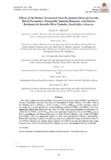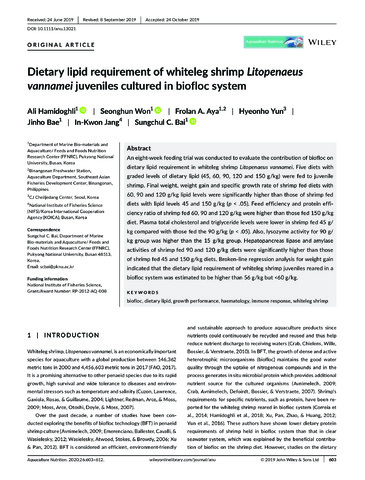Improved survival and growth of silver therapon Leiopotherapon plumbeus early juveniles through co‐feeding with Artemia and commercial feeds
- Global styles
- MLA
- Vancouver
- Elsevier - Harvard
- APA
- Help

閲覧/開く
日付
2021-12Page views
254ASFA keyword
AGROVOC keyword
Metadata
アイテムの詳細レコードを表示するCited times in Scopus
Share
抄録
This study examined the effects of co-feeding Artemia and commercial feeds on survival, growth and fatty acid composition of silver therapon Leiopotherapon plumbeus early juveniles. Triplicate groups of 36 days post hatch (DPH) early juveniles (17.09 ± 1.69 mm; 0.07 ± 0.02 g) were stocked in nine glass aquaria at 25 individuals per aquarium and reared for 60 days on three feeding regimes: (A) Artemia + powdered commercial tilapia feed (35% crude protein (CP)); (B) Artemia + powdered commercial prawn feed (38% CP); and (C) Artemia nauplii only as the control group. Early juveniles co-fed Artemia and commercial feeds had significantly higher survival (97%) than those fed Artemia alone (86%). Except for the condition factors that were similar to the control group, higher mean total length (30.2 ± 1.3 mm and 27.6 ± 1.2 mm), body weight (401 ± 64 mg and 339 ± 46 mg), length- (SGRL; 0.95 ± 0.07%/day and 0.80 ± 0.07%/day) and weight-specific growth rates (SGRW; 2.85 ± 0.27%/day and 2.58 ± 0.22%/day) were also observed in the co-feeding groups, independent of protein, fat and other nutrient levels in commercial feeds. Higher levels of long-chain polyunsaturated fatty acids were reflected in early juveniles co-fed Artemia and commercial feeds than those fed exclusively on Artemia contributing, in part, to the higher growth and survival observed in the co-feeding groups. Together, these results suggest that co-feeding strategy showed best results in terms of growth and survival, and that commercial feed with 35% protein and 6% crude fat levels may be beneficial in supplementing live feed with essential nutrients to optimize production of silver therapon fry during nursery culture.
Suggested Citation
Aya, F., Nillasca, V. S. N., & Garcia, L. M. (2021). Improved survival and growth of silver therapon Leiopotherapon plumbeus early juveniles through co‐feeding with Artemia and commercial feeds. Journal of Applied Ichthyology , 37(6), 925-931. https://doi.org/10.1111/jai.14277
Type
ArticleISSN
0175-8659; 1439-0426Collections
- Journal Articles [1229]
Related items
Showing items related by title, author, creator and subject.
-
Effects of the dietary fermented tuna by-product meal on growth, blood parameters, nonspecific immune response, and disease resistance in juvenile olive flounder, Paralichthys olivaceus
Oncul, Fatma Ozgun; Aya, Frolan ; Hamidoghli, Ali; Won, Seonghun; Lee, Geon; Han, Kyoung R.; Bai, Sungchul C. (World Aquaculture Society, 2019)
This study evaluated the effects of dietary fermented tuna by‐product meal (FTBM) in juvenile olive flounder, Paralichthys olivaceus. Five diets were formulated to replace fishmeal (FM) with FTBM at 0% (FTBM0), ...
; Hamidoghli, Ali; Won, Seonghun; Lee, Geon; Han, Kyoung R.; Bai, Sungchul C. (World Aquaculture Society, 2019)
This study evaluated the effects of dietary fermented tuna by‐product meal (FTBM) in juvenile olive flounder, Paralichthys olivaceus. Five diets were formulated to replace fishmeal (FM) with FTBM at 0% (FTBM0), ... -
Evaluation of plant proteins as partial replacement for animal proteins in diets for Penaeus indicus and P. merguiensis juveniles
Peñaflorida, Veronica D. (Society of Israeli Aquaculture and Marine Biotechnology, 2002)The growth rate and survival of two white shrimps, Penaeus indicus and P. merguiensis, fed diets in which fishmeal was partially replaced with plant protein sources were investigated in three trials. In trial 1 with P. ... -
Dietary lipid requirement of whiteleg shrimp Litopenaeus vannamei juveniles cultured in biofloc system
Hamidoghli, Ali; Won, Seonghun; Aya, Frolan ; Yun, Hyeonho; Bae, Jinho; Jang, In-Kwon; Bai, Sungchul C. (Wiley, 2020-06)
An eight-week feeding trial was conducted to evaluate the contribution of biofloc on dietary lipid requirement in whiteleg shrimp Litopenaeus vannamei. Five diets with graded levels of dietary lipid (45, 60, 90, 120 and ...
; Yun, Hyeonho; Bae, Jinho; Jang, In-Kwon; Bai, Sungchul C. (Wiley, 2020-06)
An eight-week feeding trial was conducted to evaluate the contribution of biofloc on dietary lipid requirement in whiteleg shrimp Litopenaeus vannamei. Five diets with graded levels of dietary lipid (45, 60, 90, 120 and ...




